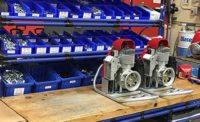Cummins Inc., founded in 1919, designs, manufactures, sells and services diesel engines and technology globally. Between its four business units, Cummins has 107 manufacturing plants, 600 company-owned and independent distribution facilities and over 5,000 dealer locations in more than 160 countries.
In 2013, Cummins began a company-wide initiative to establish a standardized global ergonomic assessment methodology. It also sought a data-driven approach to manage the process.
At the time, data entered into workstations indicated that nearly 45 pounds of excessive torque stress was regularly being placed on workers. This definitely got the attention of management and made them aware that something had to be done, says Chris Shieldsmith, corporate ergonomics specialist at Cummins.
Shortly thereafter, in 2014, Cummins connected with Humantech as an ergonomics partner and implemented the Humantech System (THS). This system—a software-as-a-service application for managing workplace ergonomics in production, assembly, distribution and service environments—helped the company transition from using lagging indicators to leading indicators.
“Looking in the rearview mirror to develop business processes and improvements is reactive. Lost work days and injury data are important to know, but they shouldn’t be the decision-making factors,” explains Shieldsmith.
Instead, Cummins began predicting which events could occur and developed preventive programs, such as providing ergonomics training to team members and completing risk assessments. THS allows employees to attend online training as needed and at their convenience.
“We don’t have to wait months to teach people how to identify musculoskeletal disorder (MSD) risk factors. A new employee can attend
ergonomics training the first week of his or her employment, and be on the shop floor assessing and identifying high-risk jobs during the second week. THS has become a ‘one-stop shop’ for ergonomics,” says Shieldsmith.
THS includes online training and tools to help deploy, monitor and track the ergonomics process. The data entered into the job assessment portion of the system results in a scored and color-coded executive summary report, categorizing jobs as either high (red), medium (yellow) or low (green) risk. The report also includes a human image showing the body areas that are affected by the different risk levels.
After companies have their teams complete the appropriate online training modules, the teams work alongside Humantech certified professional ergonomists to determine and improve problem areas.
This is achieved by monitoring the teams’ progress and generating reports focused on risk maps, root causes and levels of improvement.
“THS’s ability to identify and aggregate global MSD risk data has transformed the way we prioritize and mitigate MSD risk. The data-driven outputs of THS have allowed us to make a strong business case and justify the necessary improvements to management,” says Shieldsmith.
One improvement in particular, the “Knight Knuckle,” was inspired by the collected MSD data and designed by Kendrick Knight, a tool builder at Cummins’ Jamestown Engine Plant. The tool is installed onto a current bar fixture, and when used, eliminates all torque forces on the operator. It allows nearly infinite range of motion, enabling the operator to get access and tighten joints in virtually any plane.
Since implementing THS, Cummins has completed more than 7,000 assessments and has completed or planned over 2,700 improvements. Its incidence rate dropped from 0.8 percent in 2013 to 0.12 percent in 2016—a savings of more than $4 million in efficiency and productivity, and $12 million in injury cost avoidance.
For more information on ergonomics software, call 734-663-6707 or visit www.humantech.com.


